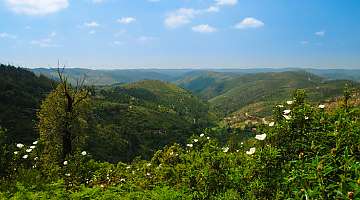The Different Side of Algarve

Published on
Visit Algarve, nestled among peaceful hinterland and the traditional villages, and discover a completely different Algarve. Wondering how to reach this secret world that has been preserved from the past? It’s simple… all you do is follow the arrows.
Marked with both signs and interpretive panels, this infamous footpath has been named “Algarve Way”, and it runs from the region east to west. The path has origins in a trail that had been traditionally used by pilgrims heading toward the Sagres promontory, which is where the relics of St. Vincent were later found. Running from Alcoutim, along the banks of the River Guadina, and to Cape St. Vicnent, there is a 300K path divided into 14 sections. Each of these sections begin and end with a place where visitors can enjoy lodging and refreshment. It has been designed so hikers can take their journey at their own pace, or simply choose the sections that appeal to them the most.
Taking a trip into the center of nature begins in Alcoutim, on the banks of River Guadiana. This crosses over to the Serra Do Caldeirao, which is where the villages of Salir, Benafim and Alte are located. Halfway along this stretch, the path also passes through the village of Sao Bartolmeau de Messines, then continues along the riverbanks of Riberia do Arade. The views along this section are spectacular. Silves is another good place to visit, before going on to the Serra de Monchique, with breathtaking panoramas that can best be seen from the highest points in Algarve (Picota or Foia). While crossing some untamed countryside, the path will pass through Marmelete, Bensafrim and San Joao. You will then pass a forest of stone pines, and the sea is getting close as you reach the end of the trail in South West Aletejo and the Costa Vincentina Nature Park. This is Europe’s most well preserved stretch of coastline.
While on the path, you will be able to admire much vegetation, including rosemary, fennel, lavender, thyme, heather and rock rose. Some even see orchids, although these are rare. Trees and shrubs found include fig trees, carob and cork, and almond trees. The almond trees provide the materials for sweets from the area.. The Ilqueurs River and the streams nearby cool visitors on hot days, while the natural habitat offers views of otter and other species. Parts of this region are claimed by te Natura 2000 network, where you can spot wild hares, boars and foxes. There may even be a lynx spotted. Birds that may be seen include the rufous bush robin, and possibly a bee eater. Using binoculars, a closer look may reveal a Bonelli eagle or eagle owl, which prefer higher terrain.
In a region to the north, you will find farmers using traditional farming methods. You can find windmills, threshing floors and the unique community oven. The houses are traditional white lime washed, and topped with a delicate, lace patterned chimney pot specific to Algarve. The residents are friendly and welcome, preserving the traditions of the old world. They produce some flavorful drinks and food, including an arbutus berry brandy, liquors created from almonds, cheeses sausages, and honey offer a unique set of flavors to take home. The local handicrafts are perfect souviniers to take home, offering a sample of the skills of the locals in woven articles, pottery and other crafts.
Make sure to wear some comfortable clothes, including sturdy footwear for hiking. You might also want to have a compass or GPS as well, along with other practical hiking tools. Make sure you have checked the Algarve Way website to have specific information, then start walking.
For more inforrmation on the the Algarve and Algarve property for sale contact the Portugal real estate team via email at: info@portugalproperty.com or call free on +44(0) 800 0148201
Published in: Guide to Portugal